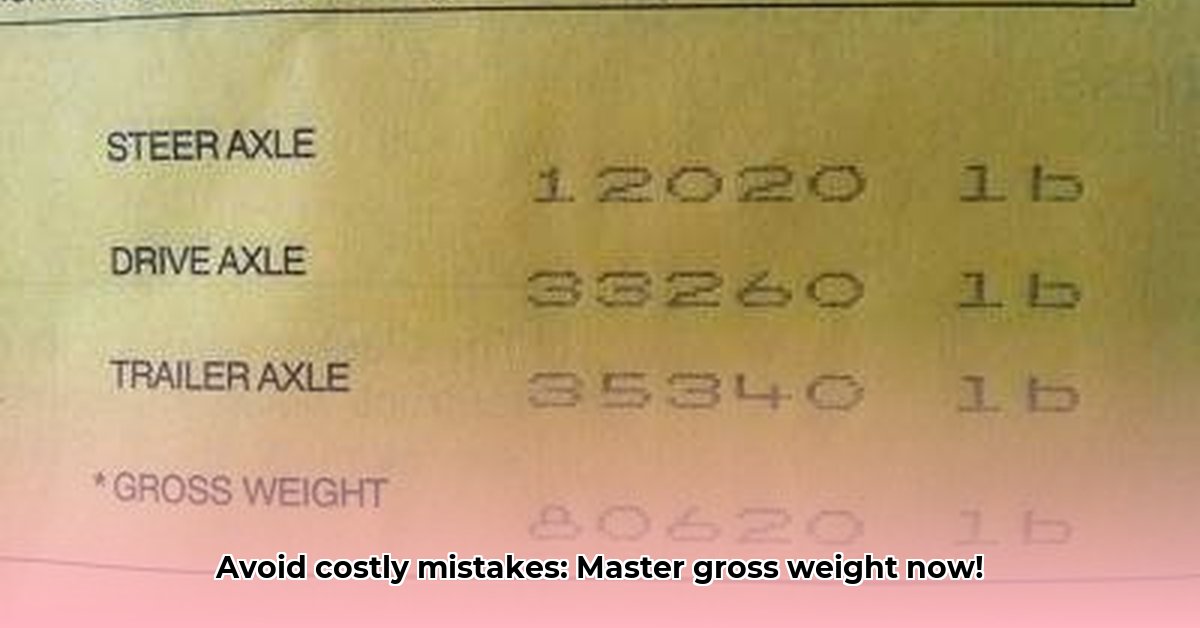
Understanding Your Gross Vehicle Weight Rating (GVWR) and Axle Weight Limits
Mastering the gross weight of your tractor-trailer is crucial for avoiding fines, preventing accidents, and ensuring operational efficiency. This involves understanding two key metrics: Gross Vehicle Weight Rating (GVWR) and axle weight limits. Your GVWR (the maximum weight of your entire truck and its contents) is printed on a sticker typically located inside your driver's door. In the U.S., many rigs are limited to 80,000 pounds, but this can vary. However, exceeding your GVWR, even slightly, can result in hefty fines, delays, and potentially dangerous situations. For more information on accident prevention, see this recent truck accident.
But it's not just about the total weight. Each axle on your truck has a maximum weight limit—the weight each wheel and its assembly can handle before potential damage and breakdown occur. These limits are often overlooked yet crucial. Exceeding axle weight limits, even if your overall gross weight is below the GVWR, is also illegal and dangerous, impacting road infrastructure and increasing accident risk. Furthermore, these limits vary by state, demanding vigilance during interstate travel. Think of it like this: while your overall weight is like the total capacity of a building, the axle weight limits are like the maximum load-bearing capacity of each individual floor.
Pre-Trip Weigh-ins: A Crucial First Step
Before starting your journey, weigh your truck at a certified scale (easily found at many truck stops and weigh stations). This pre-trip inspection is not just about avoiding fines; it's about proactive safety. Regular weigh-ins allow you to identify any weight discrepancies before they become major problems. "Regular weighing is paramount to preventing accidents and costly repairs," says Dr. Emily Carter, Lead Transportation Engineer at the National Transportation Safety Board. Imagine detecting a weight issue before you’re halfway to your destination; that's the kind of preventative measure that saves you time, money, and potential disaster. Don't underestimate the importance of this step.
Smart Loading Techniques: Optimizing Weight Distribution
Effective load planning is essential for both compliance and efficiency. Heavier items should be strategically positioned near the center and over the axles to optimize weight distribution and prevent axle overload. Remember to account for the weight of fuel; a full tank adds substantial weight. "Strategic load planning isn't merely a best practice, it's a necessity for preventing catastrophic accidents," emphasizes Captain John Miller, veteran trucker and safety consultant at the American Trucking Associations. Furthermore, some drivers utilize specialized software to aid in load planning, maximizing cargo capacity while remaining within legal weight boundaries. This thoughtful approach minimizes risks and cuts down on potential issues.
The Consequences of Non-Compliance: Why Legal Weight Matters
Ignoring weight limits carries severe consequences beyond fines. Delays, potential truck damage (leading to costly repairs), and damage to road infrastructure (affecting everyone) can significantly impact your bottom line. "Beyond the monetary penalties, operational inefficiencies and reputational damage due to violations are a serious concern," notes Sarah Chen, Logistics Manager at Global Supply Chain Solutions. Moreover, exceeding weight limits jeopardizes safety. Think about the risk you're taking, driving an overloaded truck. These are not just rules; they are safeguards to prevent accidents and help maintain operational efficiency.
Step-by-Step Guide to Optimized Weight Management
Here's a practical, 5-step process to ensure your loads always meet regulations:
- Pre-Trip Inspection: Thoroughly inspect your cargo and equipment before loading.
- Accurate Weighing: Utilize certified scales to determine the exact weight and axle weight distribution.
- Strategic Loading: Carefully position heavy items to centrally distribute the weight.
- Fine-tuning: Adjust the 5th wheel and trailer tandem axle placement if necessary.
- Post-Trip Review: After delivery, review the data to identify areas for improvement.
Following this process will minimize your risks and help you maintain a safe and profitable operation.
Table: Common Weight-Related Violations and Their Penalties
| Violation | Typical Penalty Range | Potential Impacts |
|---|---|---|
| Exceeding GVWR | $1,000 - $10,000+ (varies widely by state and severity) | Fines, delays, accidents, potential legal issues |
| Exceeding Axle Weight Limits | $100 - $5,000+ (varies widely by state, axle, and severity) | Fines, road damage, accidents, potential legal issues |
| Incomplete or Inaccurate Logs | $100 - $500+ (varies by state and number of violations) | Fines, legal challenges, license suspension |
Remember, responsible weight management is an investment in safety, compliance, and long-term business success. Prioritize safe practices and careful planning to protect your business and the lives of others on the road. By understanding GVWR, adhering to axle weight limits, and adopting smart loading practices, you’ll ensure smooth, legal, and ultimately more profitable operations.